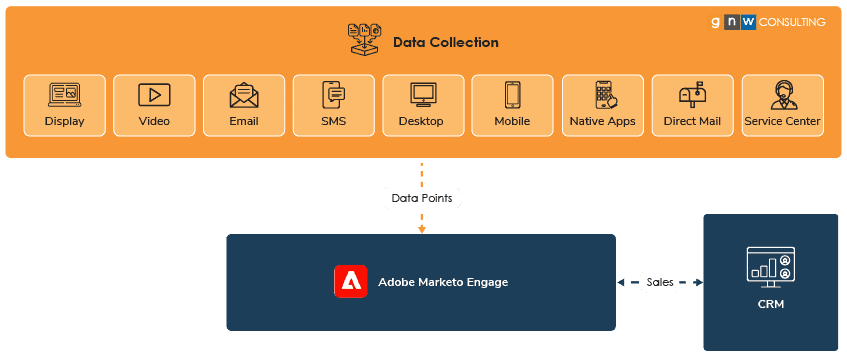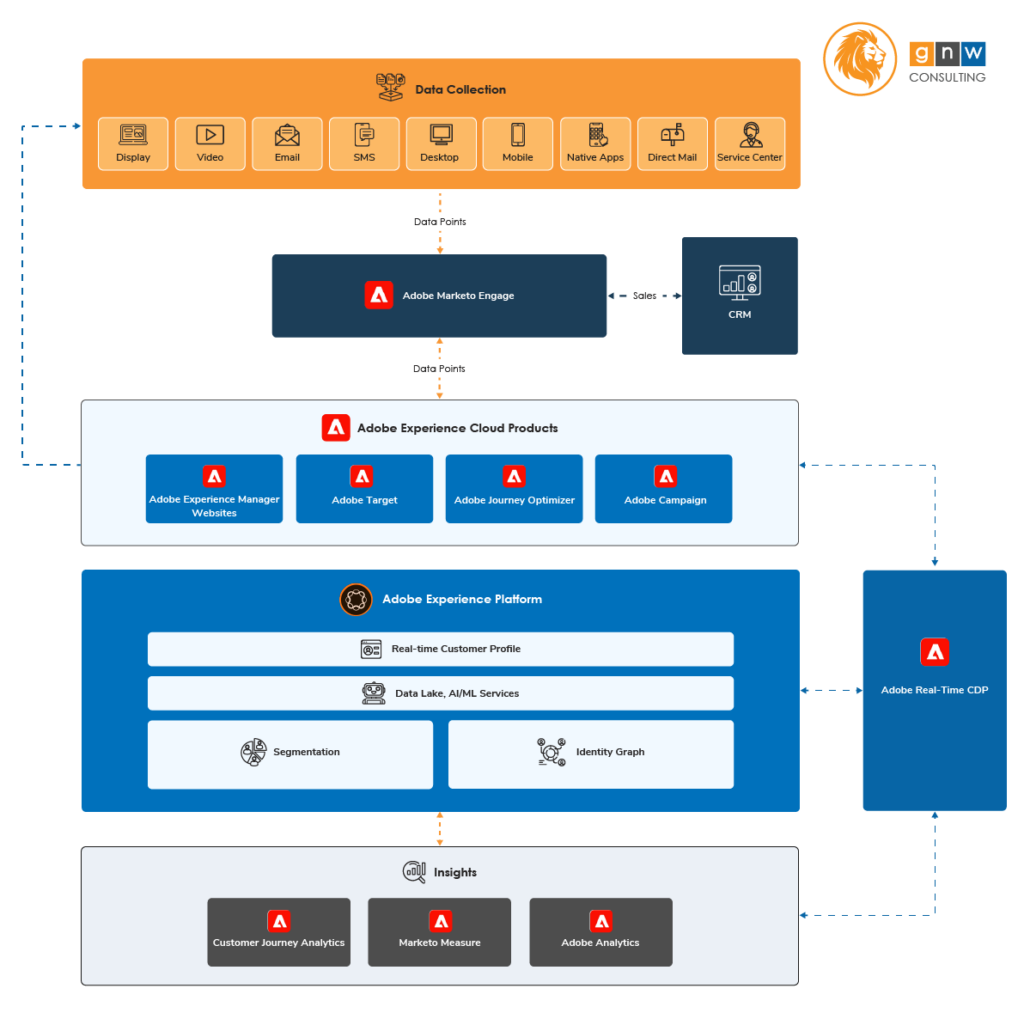Adobe Summit 2025 made one thing crystal clear: Adobe is investing in Marketo.
After years of speculation about its role in the Adobe stack, Marketo is now being positioned exactly where it adds the most value. Not as a jack-of-all-trades marketing platform, but as the entry point for B2B growth. It is the engine that captures demand, qualifies it, and signals when it’s time to move deeper into the buyer journey.
Marketo excels at early-stage intent capture. Web forms, gated content, event registrations, and conversational chat all contribute to where leads are born. Its strength has always been in turning anonymous engagement into marketable demand. Now, with generative AI layered in, it’s not just capturing activity. It is enhancing how content is created, scored, and routed in real time.
But the real story coming out of Adobe Summit was bigger than just Marketo.
Adobe is moving away from the idea that any one product should try to do it all. Instead, it is assembling a connected ecosystem that mirrors how modern growth teams actually operate. Marketing is not linear. It moves across platforms, teams, channels, and tools. Adobe’s stack is now reflecting that reality.
Marketo captures the signal. AEM and GenStudio deliver content and creative at scale. AJO personalizes and orchestrates the journey. AEP with Measure ties it all together with data, attribution, and insights.
This is not about making Marketo do more. It is about making the whole stack work better together and letting Marketo shine in the role it was built for.
The Future of the Tech Stack Is Integrated, Not All in One
The days of trying to force a single platform to handle the entire marketing funnel are behind us. The future is not about stuffing more features into one tool. It is about creating a connected ecosystem where each solution does what it does best and passes data, content, and context seamlessly across the stack.
This is especially true for growth teams. We do not just need automation. We need agility, insight, and orchestration. And that only happens when your lead capture engine, your content delivery engine, your personalization tools, and your analytics all talk to each other without friction.
That is exactly what Adobe is building. Here is how the pieces are starting to fit together.

Adobe Marketo Engage: Demand Capture and Lead Scoring
Marketo is still the best tool for engaging buyers at the top of the funnel.
- It powers forms, webinar registrations, gated content, and conversational chat
- Generative AI enhancements now help scale content creation across email, webinars, and chat
- Lead scoring, triggered workflows, and routing logic push qualified interest deeper into the funnel
This is where demand enters the system.
AEM and GenStudio: Content at Scale
Once demand is captured, Adobe’s content stack steps in.
- Adobe Experience Manager governs digital experiences including web, landing pages, and asset delivery
- GenStudio adds speed and scale through generative AI, helping marketers version and adapt content by persona, product, or stage
- With native integration between AEM Assets, Adobe Express, and Marketo, creative stays consistent and on brand across platforms
This is where content becomes personalized quickly and efficiently.

Adobe Journey Optimizer B2B Edition: Real-Time Orchestration
Now that demand is qualified and content is ready, AJO B2B activates journeys in real time.
- Built on Adobe Experience Platform, it triggers multichannel experiences across email, web, push, and outbound sales
- Journey logic adapts using real-time data and predictive models, moving leads to the next best step
- AJO can also send leads back into Marketo when re-engagement or nurturing is needed
This is where journeys are mapped and executed.
Adobe Experience Platform and Marketo Measure: Analytics and Attribution
Behind it all is the analytics layer, making sure every decision is informed by real performance data.
- Marketo Measure tracks multi-touch attribution across every channel and campaign
- Adobe Attribution AI enhances this with predictive insight into what is actually driving pipeline
- Real-time activity from Marketo feeds directly into AEP or external BI tools, with no API bottlenecks
- Dashboards, influence modeling, and lifecycle views make marketing ROI visible and actionable
This is where strategy becomes data driven.


Why This Matters
Over the years, Marketo introduced a number of add-ons in an attempt to expand its functionality. Web Personalization, Predictive Content, Revenue Cycle Modeler, Account Profiling. The list goes on.
Most of these features were built with good intent, but in practice, they often felt disconnected from how teams actually worked. Adoption was limited. Usability was clunky. In many cases, they created more operational overhead than value. They were siloed answers to broader needs.
What we are seeing now is Adobe acknowledging that reality and solving it the right way.
- Web Personalization is no longer a bolt-on feature. It now lives inside AEM and GenStudio, where dynamic experiences can be delivered at scale, governed centrally, and powered by unified data
- Revenue Cycle Modeler evolves into AJO B2B, which allows teams to map, orchestrate, and adapt journeys using real-time behavior and cross-channel logic rather than static diagrams
- Predictive content and account scoring are being reimagined through the lens of Adobe Experience Platform and Attribution AI, where decisions are made using machine learning across the full stack
This is the future of the tech stack. It is not about adding more features into a single platform. It is about building an interconnected system that shares data, insights, and logic to deliver the right experience at the right time.
Scaling with Intent, Not Add Ons
The future of marketing technology is not about a single platform that does everything. It is about a cohesive ecosystem that companies can grow into over time.
Marketo was being geared as an all in one solution. Adobe is now taking a more strategic approach by building a connected architecture where each part of the stack plays a specific role and scales with the needs of the business.
- Marketo captures and qualifies the signal
- AEM and GenStudio scale content and manage experiences
- AJO B2B orchestrates journeys across channels
- AEP and Marketo Measure analyze performance and inform strategy
This is not about cramming more features into one tool. It is about building a system that grows with you, supports specialization, and stays aligned to how modern growth teams actually work.
It is not just about functionality. It is about fit, flexibility, and long-term scalability.
A Smarter Path to Adoption
This connected approach does not just make sense from a strategic standpoint. It also creates flexibility from a pricing and adoption perspective.
Instead of buying into a monolithic platform filled with features you may never use, companies can start with what they need today and expand into the ecosystem as they grow.
- Need to capture and qualify demand? Start with Marketo
- Need to personalize content across web and email? Layer in AEM and GenStudio
- Ready to orchestrate across channels? Add AJO B2B
- Want deep attribution and real-time performance insight? Connect to AEP and Marketo Measure
This model allows teams to grow into the tools that make sense for their stage and goals. It avoids paying for what is not needed and reduces the risk of outgrowing what has already been invested in.
It is a stack built for scale but flexible enough to start small. And that is exactly how modern growth teams win.

Where Real-Time CDP Fits In
At the center of Adobe’s B2B stack is the Real-Time Customer Data Platform, built on Adobe Experience Platform. This is not just a data warehouse. It is the connective layer that makes real-time personalization, orchestration, and analytics possible.
Here is how it powers the rest of the ecosystem:
- In Marketo, Real-Time CDP enriches lead and account profiles with behavioral, demographic, and firmographic data from across systems
- In AEM and GenStudio, it enables content to be dynamically personalized based on unified customer profiles
- In AJO B2B, it drives journey logic and next best action decisions by reacting to behavior and intent signals as they happen
- In Marketo Measure and Attribution AI, it ties all touchpoints back to a single identity for accurate multi-touch attribution
Real-Time CDP turns disconnected data points into actionable profiles that can be activated across every part of the stack. It ensures that every tool is working from the same source of truth, in real time.
For companies looking to scale without adding complexity, this is the layer that brings clarity, speed, and precision to every stage of the customer journey.
My Thoughts
This is how I see the next generation of marketing technology evolving. Not as a race to build the most features into a single platform, but as a move toward modular, connected ecosystems that give teams what they need when they need it. Tools should be interoperable. Data should be unified. Growth should feel scalable, not constrained. Adobe’s approach reflects that future. One where strategy leads, platforms support, and companies grow into the capabilities that truly move the needle.

